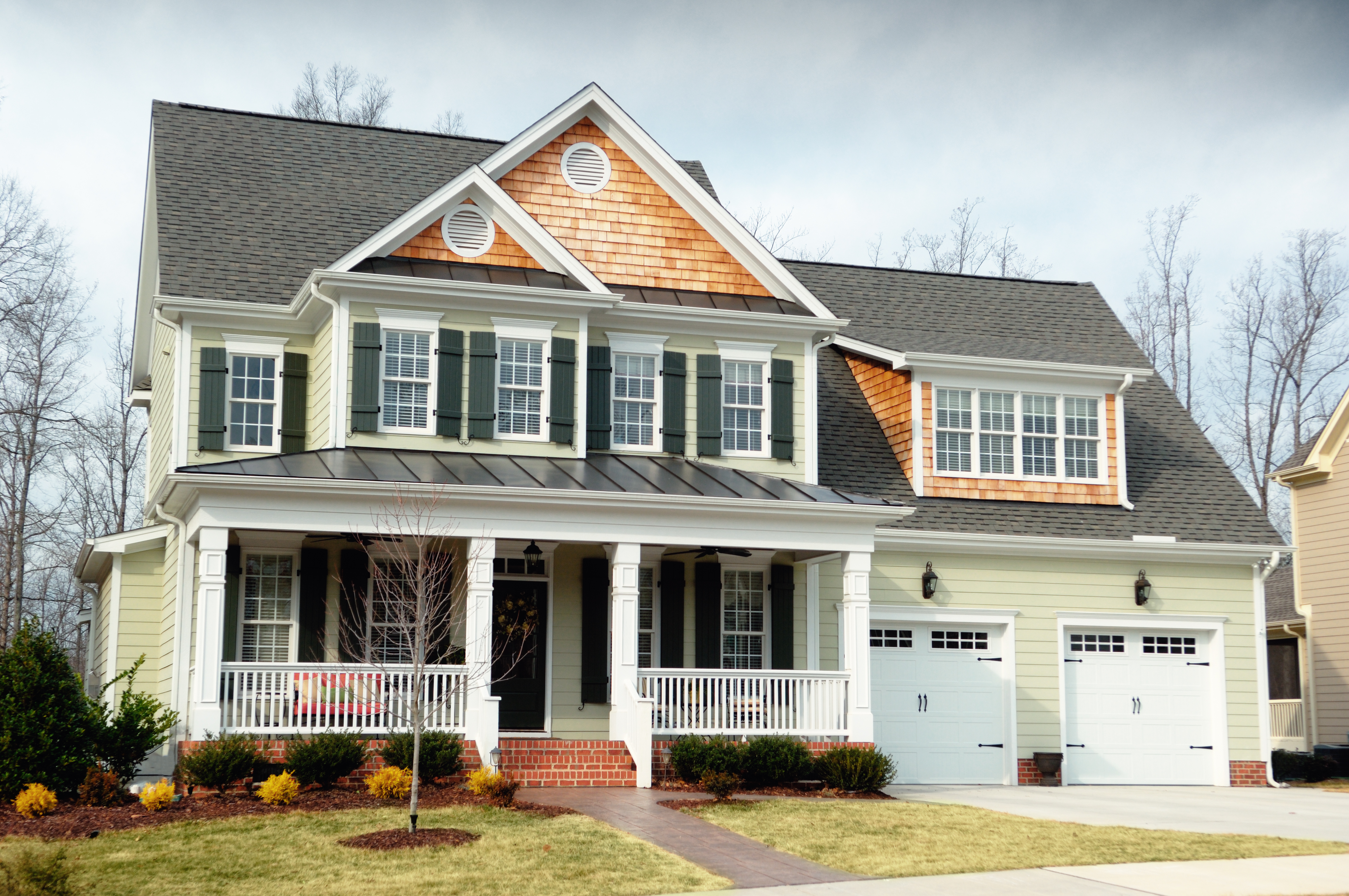
Dealing with a visibly damaged roof or leak? Learn about roof repair costs in Columbus to see how much you’ll need to budget for a permanent solution.
Let’s add a new layer to the topic of roof replacement


With a roof overlay, you lay new shingles over old ones rather than tearing them off first.
Roof overlays are more affordable than a full roof replacement.
You can only overlay a roof once.
Not all pros recommend roof overlays because they can cover up damage instead of addressing the problem.
When you eventually have to replace the roof, it is more expensive to do so with two layers of shingles.
If you notice signs that you need a new roof, you may be worried about whether you can afford to replace it. But there is a budget-friendly alternative to installing a new roof—a roof overlay. Read on to learn everything you need to know about the process of overlaying a roof, how it compares to a complete roof replacement, and the circumstances in which overlaying shingles on an existing roof may be the right choice.
An alternative to a tear-off roof replacement, roof overlay (sometimes called “roof recovery”) is the process of applying new shingles and waterproofing to an existing roof. Rather than removing the old shingles and ripping out the old flashing and sealing, roofers simply cover them with a new layer. Compared to full roof replacement costs, an overlay significantly reduces the costs of labor and materials disposal.
There is a catch, though; it can only be done once. After you add one layer of overlay shingles, your roof likely cannot support another layer, and most building codes allow a maximum of two layers of organic or fiberglass shingles on roofs with a pitch up to 18.5 degrees. And if you have major underlying problems with the original roof, an overlay is unlikely to correct them. Shingles that are warped and sagging will still look warped and saggy with another layer on top. Somewhat paradoxically, the best candidate for a roof overlay is a roof that is already in relatively good condition.
Not all roofers will perform overlays, either because they are wary of the merits or because they cannot be confident enough in the underlying structure to guarantee their work without the full inspection that happens during a tear-off replacement. So, if you are considering a roof overlay, speak to a range of local roofing contractors to choose a roofer who can do your job. Local building codes also tend to be quite specific about the circumstances under which an overlay is or is not allowed, so make sure to do thorough research on the requirements in your area.
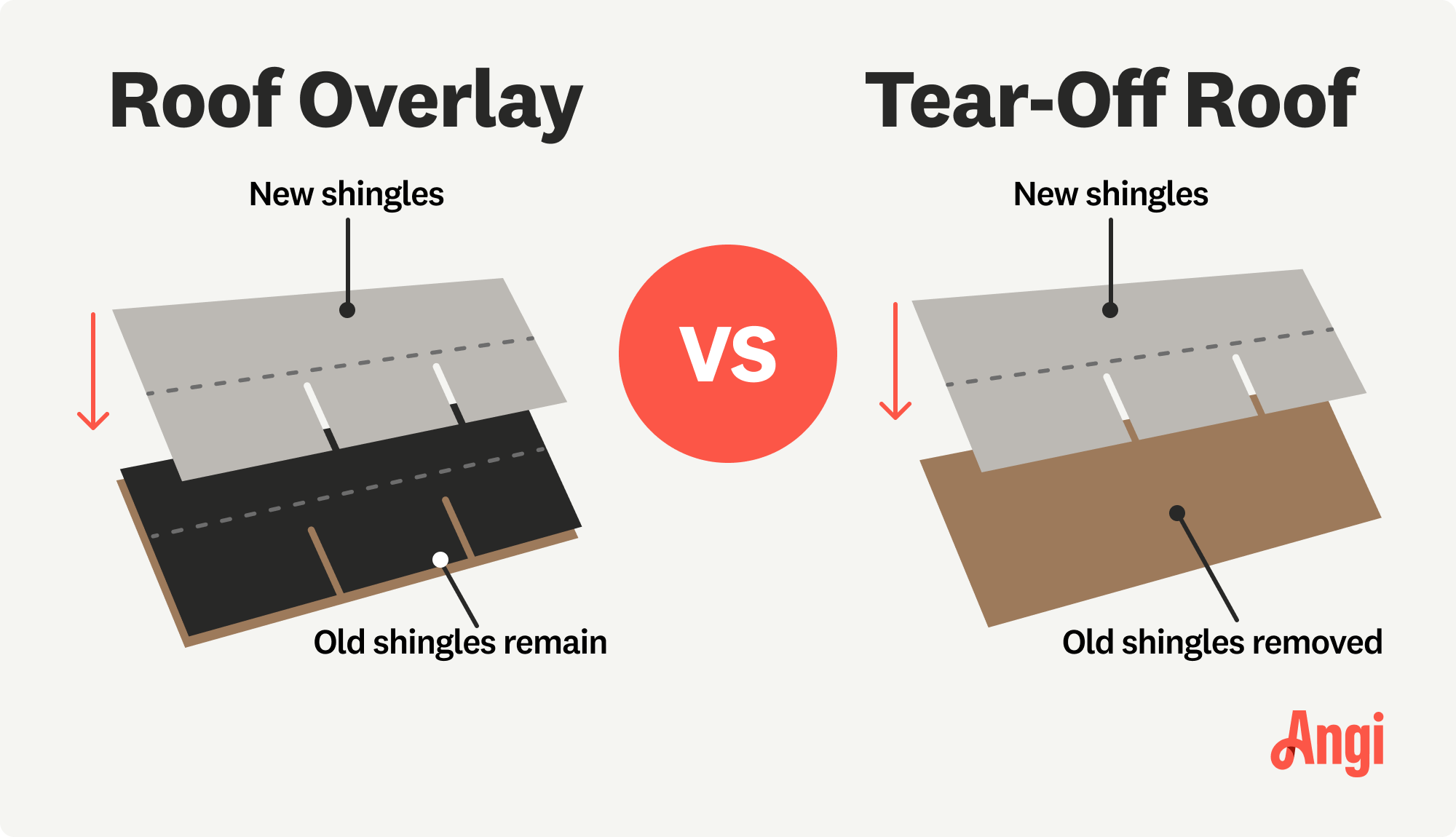
Can you shingle over shingles? Comparing the two options leaves one clear conclusion: Always go with a tear-off roof replacement, if possible.
Most expert roofers do not recommend overlaying new shingles on top of existing roofing for structural and longevity reasons. Instead, they almost always recommend roof replacement, including a complete tear-off of old shingles, inspection and repair of the roof decking below, and installation of entirely new, high-quality roofing materials that are backed by labor and material warranties.
If you must consider an overlay, be sure your contractor does it right. They should do the best inspection they can of your current roof, looking for leaks and damage. They should also explain the risks to your roof and home, warranty changes or voids, and other downsides for your specific situation. If that inspection shows no concerns and you are comfortable with the risks and downsides, they can move forward with the overlay.
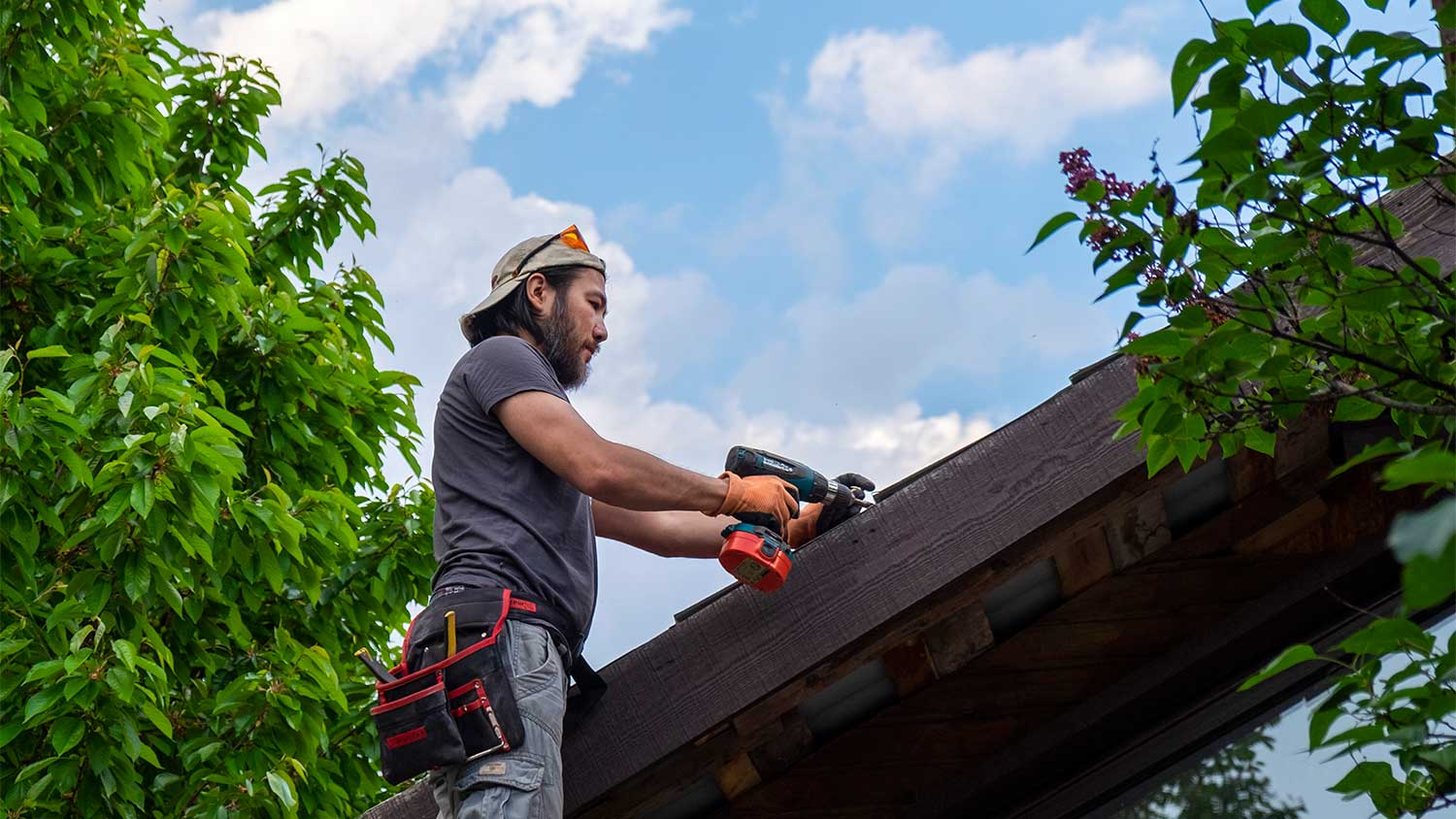
The total cost of a full roof replacement ranges between $8,700 and $22,000. Most homeowners’ primary motivation in considering a roof overlay versus a tear-off is savings. In the short term, a roof overlay is significantly less expensive than the alternative. By opting for an overlay, you skip out on paying for the labor time involved in removing the old shingles and the fees required to dispose of them, which can cost between $1 and $4 per square foot. All told, an overlay could save 20% to 40% on your roof replacement.
By opting for a roof overlay, you are essentially cutting the replacement job in half, sparing contractors the work of removing and disposing of the old shingles. In the same way it lowers costs, it cuts down on the length of the work, as well as some of the mess it creates. Your home will be under construction for significantly less time and you will not need to deal with dumpsters, piles of old shingles, and discarded old nails.
Because it does not include tearing off your old roof, roof overlays are much faster and less disruptive than complete reroofing work. You will not face hours or days of scraping overhead or having roofers on your property. This can be especially tempting for people who work from home or are home most of the time, as well as businesses that want to limit the interruption of roofing work.
The affordability and short installation time offered by a roof overlay come with their own disadvantages.
While the immediate costs of a roof overlay are much lower than a tear-off replacement, you are essentially deferring (and adding to) the costs of the tear-off replacement that will eventually have to follow. It will take longer and increase labor costs to remove two layers of shingles, and it will cost twice as much in dumping fees.
With two layers of shingles, a roof overlay doubles the amount of weight your roof must support. While most building codes will allow for the additional layer, you need to be confident that the walls and foundation of your home are not just structurally sound but in tip-top shape, capable of bearing the additional stress over many years. If your foundation requires the installation of additional supports to carry the increased roof weight, any savings from avoiding a full roof replacement will quickly vanish.
As part of the standard tear-off roof replacement process, roofers must perform a detailed inspection of the roof deck beneath the shingles to catch and correct any problems with the structure, as well as the flashing or sealing. With an overlay, the first layer of shingles stays in place, so if the deck is rotting, leaking, or has other structural issues, you will not catch it until there is an evident problem. It is for this reason that some roofing contractors refuse to perform overlays since they are unable to inspect the underlying roof carefully enough to make the standard assurances of quality.
The average lifespan of a roof with asphalt shingles falls between 20 and 30 years. In principle, the second layer of shingles added in a roof overlay should last the same amount of time, but in reality, it rarely does. How long does a roof overlay last? Roofers say that homeowners should expect the average overlay to last 15 years.
The main culprit in limiting the longevity of an overlay is heat. The sun beats down heavily on a roof, with the dark shingles absorbing much of its heat. When there are two layers of shingles, heat gets trapped between them, accelerating the aging process for the top layer and sometimes causing them to warp and curl. In many cases, using shingles for an overlay will also void the manufacturer’s warranty since shingles are designed to lie flat.
If you are considering a roof overlay, inevitably, it is because you have some problems with your existing roofing. In many cases, adding a second layer of shingles will fail to hide, or can even exacerbate, the cosmetic problems that are already present. If the underlying shingles are curled or warped, the new ones will settle into the same shape. Even when the bottom layer is relatively even, it is a lot more difficult for a roofer to lay a smooth, neat layer on top of shingles when compared to wood decking. Because shingles are designed to be laid on a flat wooden surface, they may also be less stable in an overlay, catching and blowing off in high winds or heavy precipitation.
Even an attractive, well-installed roof overlay can be a red flag to buyers, lowering the sale price of your home. The fact that you had the overlay performed can make buyers wary about the state of the underlying roof, and even if they can be assured that there are no major structural problems, they know they will be inheriting an additional expensive roof replacement when the time comes. At the very least, a roof overlay will fail to increase the value of your home in the way that a full roof replacement would; in many cases, it can lower the value beneath the costs of the overlay, resulting in a negative ROI.
With an overlay in place, standard roof maintenance work can become trickier. If, for example, your roof starts leaking, it is a lot more difficult to identify the source and get at it to repair, since there is an additional layer of shingles to work with.
Perhaps surprisingly, if you insist on a roof overlay, your best option might be to place a metal roof on top of your old shingle roof. Here is why:
Metal roofing systems are lightweight, with most weighing less than a pound per square foot, so they do not add as much of a load to your existing roof system as a second layer of shingles.
Metal roofs often require or benefit from an added layer of insulation between the metal sheets and the roof decking to help block temperature changes to the attic and provide sound insulation. An old shingle roof can provide this insulating value.
Since metal roofs are usually much more durable and do a better job of preventing leaks than shingles, the risk of leaks through the underlying roof is reduced compared to shingle-on-shingle overlays.
If you choose a standing seam metal roof as the overlay, you will not need to worry about stray screws or shingle nails piercing the underlying shingles and creating new leaks. Unfortunately, however, the reverse is true: Adding a screw-down metal roof on top of an old asphalt shingle roof can be a recipe for future leak disasters.
Similarly, you can overlay a new metal roof on top of an aging metal roof. Like with overlaying asphalt shingles, this process is not recommended as much as replacing the old roof with a new one, but it can be a decent solution in some situations. It can save labor, time, money, and disruption. But it comes with challenges and downsides, too, and you should always discuss these with your roofing contractor before making a decision.
Some roofers will overlay old metal roofs with TPO (thermoplastic polyolefin) or PVC (polyvinyl chloride) membrane, both of which are single-ply white membrane roofing materials used most commonly on flat roofs. This is an uncommon overlay approach that is not often used on residential buildings, but it can be a solution for commercial and industrial buildings. Like with metal-on-metal overlays, you will need to discuss the specific pros and cons of this option with your roofer to discover whether it makes sense for you.
For many homeowners, the downsides of a roof overlay outweigh the cost savings and the shorter installation time, but there are some situations in which it may be the best option.
If you are dealing with an urgent problem, like a roof leak, during a time when money is tight, a roof overlay can be a lifesaver, providing a significantly more affordable means of getting the issue under control and preventing further damage. You know that you will be paying more down the line when it eventually comes time to opt for a tear-off replacement and that you are essentially borrowing money from the future, with those additional costs functioning like interest on a loan.
A roof overlay can also be a good choice if you are looking to sell quickly and want to affordably remedy some minor cosmetic problems with your existing roof. In some cases, a recent overlay will make buyers somewhat wary, but you can dispel their fears if you properly document that the underlying roof is in relatively good shape and that the overlay was performed correctly, demonstrating that the buyers will get at least 10 to 15 years out of the new shingles.
Finally, it may make sense to choose a roof overlay over a full replacement if your roof system is in good shape beyond some cosmetic issues with the shingles and if you put the money you save on labor toward higher-quality materials than you would use otherwise.
As we have seen, there are a lot of reasons to go with tear-off reroofing rather than a roof overlay. Here are the top reasons not to choose a roof overlay.
You have an older home: Older homes may have weaker roof rafters and roof trusses since different types of roofing materials have gotten heavier over time. Older framing support systems may not be able to support the weight of an overlay.
Your home is structurally unsound: If your home needs foundation repairs or has other structural problems, skip the overlay. The added weight may worsen existing issues.
Your roof has dips or sags: Seeing warning signs that you need a new roof like dips or sags means your roof’s supports may be inadequate and won’t be able to handle an overlay.
Your roof deck is damaged: The roof deck is the part of your roof that supports the roofing material. A damaged roof deck can’t provide the necessary support for an overlay.
You have roof leaks: If your current roof leaks, adding an overlay will compound the damage and make it harder to trace the source of new leaks. Opt for a full roof replacement instead.
You want a long-lasting roof: If you want to extend your roof’s lifespan, an overlay may not be the best choice. Overlays don’t last as long as full roof replacements.
You want a roof warranty: Roof warranties from manufacturers or roofing installers may not cover overlays. If you don’t install a roof the way the manufacturer recommends by tearing off old materials first, any available warranties will likely be voided.
You’re looking for the best resale value: Overlays aren’t a selling point for most prospective buyers—the added risk of hidden problems and structural issues from the additional weight may put buyers off.
From average costs to expert advice, get all the answers you need to get your job done.

Dealing with a visibly damaged roof or leak? Learn about roof repair costs in Columbus to see how much you’ll need to budget for a permanent solution.

Learn about roof replacement costs in Columbus and what factors are at play to budget accurately and make sure you’re getting a fair price.
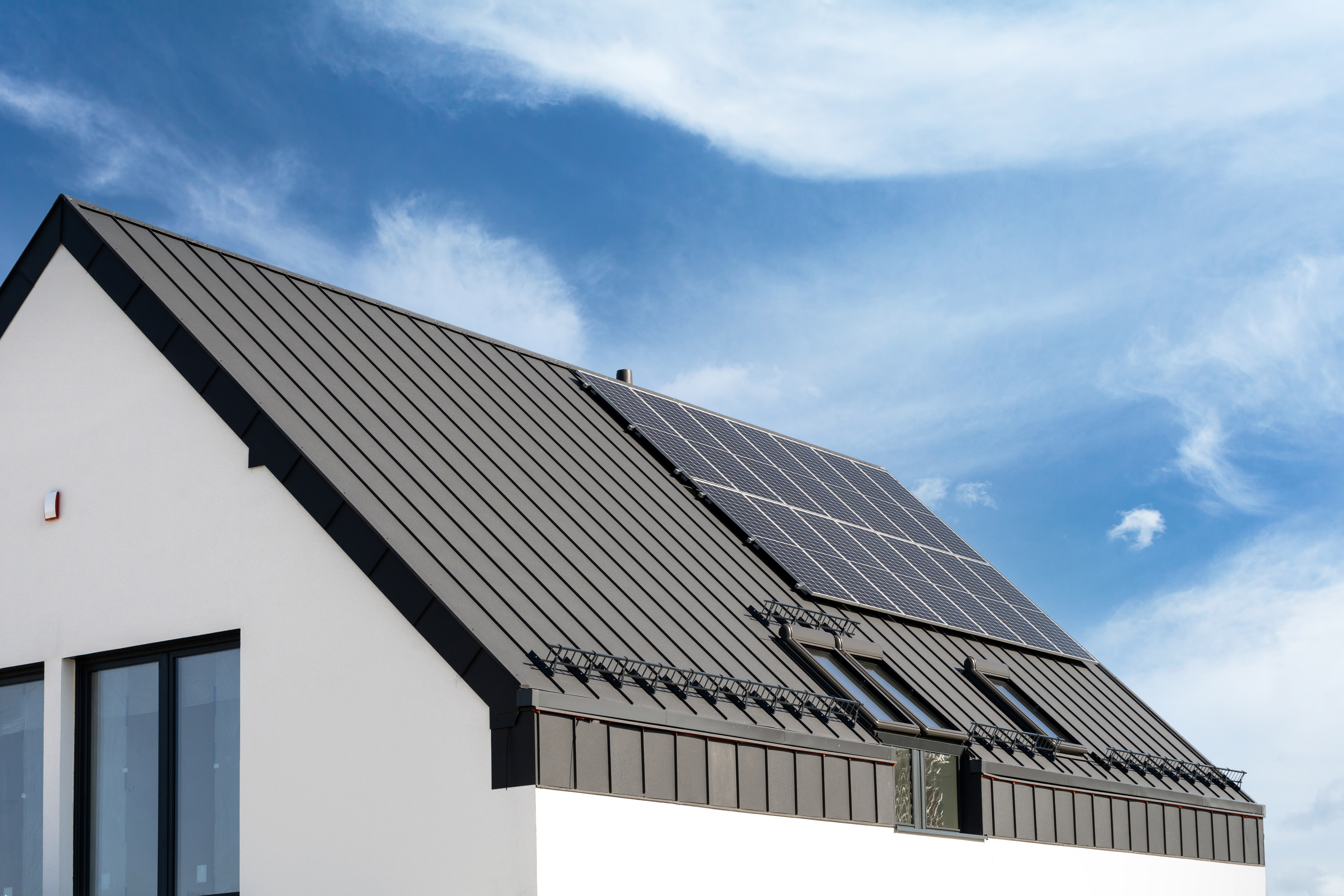
A metal roof can defend your home against Ohio’s varying weather conditions. Learn how much a metal roof costs in Columbus, OH.
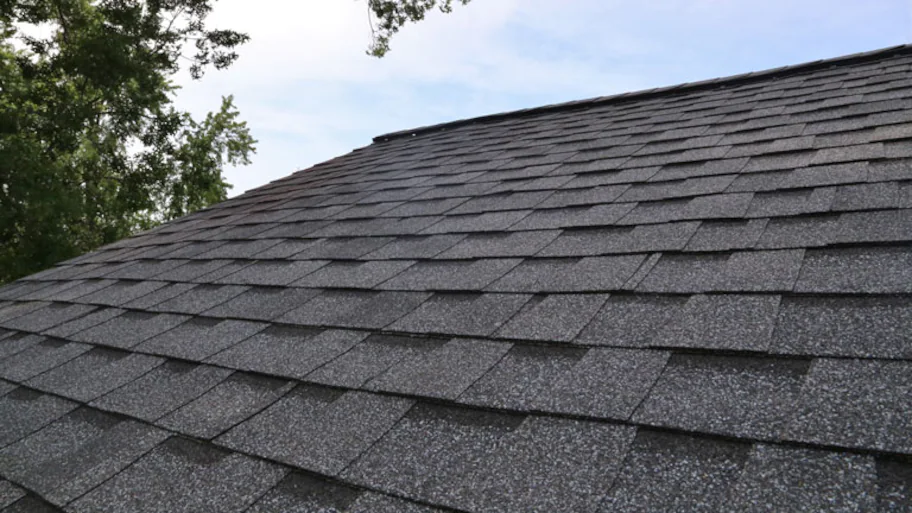
The best types of roofing materials are tailored to the local climate, energy efficient, and well suited to the roof pitch.

Understanding the styles and types of metal roofs available can help you make the best choice for your home. We’ll discuss the best options for metal roofs.

When you live in an area with sultry summers, selecting the best roof insulation for hot climates can help you save money on energy bills.